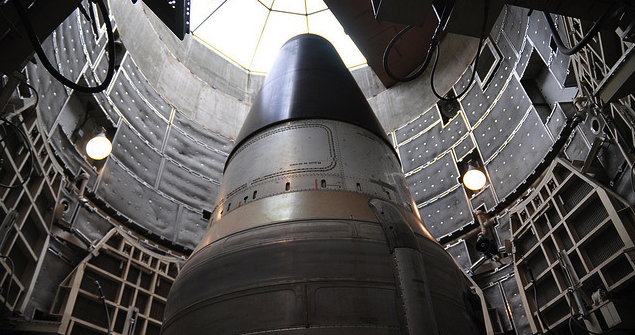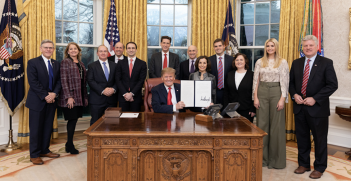Australia Needs to Support the Ban on Nuclear Weapons

Australia’s Labor Party wants to sign the new ban on nuclear weapons; here’s why there are no real impediments to doing this.
The Australian Labor Party’s conference in December passed a binding resolution to sign and ratify a United Nations treaty which outlaws nuclear weapons. Nonetheless, some in the party were sceptical, and asked for certain conditions to be met.
The resolution re-stated the value of the ANZUS alliance, and noted that a future Labor government will sign after taking account of the presence of effective verification and enforcement mechanisms, assurances that the ban-treaty will be compatible with the longstanding Nuclear Non-Proliferation Treaty (NPT) and that there is a need to work to achieve universal support for the Ban Treaty.
Shadow Defence Minister Richard Marles has said that there will have to be “certainty” that signing the treaty will not endanger the ANZUS alliance.
For his part, former Foreign Minister Gareth Evans stated that “the difficulty for Australia in terms of signing or ratifying the ban treaty is that, to do so, we would effectively be tearing up our US alliance commitment.”
Much as I respect Evans’ outstanding work on the need to prevent nuclear war, I am perplexed by his assumption that the ban-treaty is wholly incompatible with our alliance commitments.
Australians seem to fear anything which might threaten our relationship with Washington. But signing the nuclear ban, if it is done correctly, need not spell the end of our alliance.
The first point to note is that ANZUS is not explicitly a nuclear alliance, and that we are not unequivocally under a US umbrella, covered by extended nuclear deterrence. The word “nuclear” does not appear in the treaty, suggesting that ANZUS could just as easily be viewed as a mutual pact to assist each other using conventional military forces, which in all likelihood is what would happen anyway in the event of a conflict.
ANZUS commits its members to “consult together” and “act to meet the common danger” whenever the security of any one of them is threatened. This falls far short of a commitment on the part of Washington to use nuclear weapons to defend us, but since 1994 the phrase ‘extended nuclear deterrence’ has been formally linked – unilaterally, by Canberra – to ANZUS.
But even if we accept that ANZUS does provide us with extended nuclear deterrence, this does not automatically mean that we cannot sign the nuclear ban, a treaty that most of the world’s states have supported. There are some important, and yes, difficult, steps that we would have to take.
We would first need to renounce a reliance on US nuclear protection, even if that reliance has been only self-perceived and self-declared.
Given that any use of nuclear weapons would violate international humanitarian law and produce devastating consequences, given that US conventional weapons’ capabilities are phenomenal, and given that ANZUS is not explicitly a nuclear umbrella, this should not be an overly-difficult position to take.
What would be more complicated and require significant attention is the reform of our military and intelligence relationship with Washington, our “Joint Facilities” at Pine Gap and elsewhere in Australia.
Any state that wishes to sign the nuclear treaty has to pledge not to do anything to assist a nuclear weapon state in its nuclear plans. Australia would therefore have to extricate itself from all activities which might assist our ally’s policies of nuclear deterrence or plans for nuclear launch.
This would be a complex task, involving substantial technical and political challenges, but it can be done. There is important detailed work emerging which identifies how our Joint Facilities would need to be transformed, to make us compliant with the nuclear ban, and observers within Australia have already provided submissions on moving to a purely conventional weapon – or non-nuclear – alliance with the US.
Will all this annoy Washington enough to break-off our alliance completely? It could be that the necessary changes to our shared military and intelligence roles will be simply too much for the US to stomach. If so, then yes, the US might choose to “tear up the alliance.”
But it is a mistake to think that this will automatically happen, or that ANZUS is at risk in its entirety. There are some important new studies which show that it is indeed compatible for a state to remain in a military alliance with the United States and to renounce nuclear weapons. The most recent is from Harvard Law School, which concludes very clearly that “Australia can renounce its nuclear umbrella arrangement and preserve its military alliance with the United States.”
Even some NATO states are exploring ways in which they can remain in the NATO alliance while also signing up to the nuclear ban treaty. For them, the position is more complicated than it is for Australia, because these states very explicitly are under a US nuclear umbrella.
And if they can explore ways of supporting a nuclear weapons ban while remaining in an alliance with Washington, surely we can do the same? Modifying our stance on nuclear weapons will not automatically spell the end of ANZUS.
A point made by sceptics was that if the nuclear weapon states will not sign the treaty, we should not do so either. But this is disingenuous, and a stalling procedure. Over the past century, arms control processes have shown that de-legitimisation is a first step in a long process of eliminating a weapon which has come to be seen as inhumane and which contravenes international law. This has happened with biological weapons, chemical weapons, and more recently with landmines. Initially, many states possessing these weapons – including the US – did not sign up. But the moral and legal pressure placed on such states over time has meant that these weapons are now heavily stigmatised, and their possession and use have dropped dramatically.
The ban treaty will not, of course, eliminate nuclear weapons overnight. But it is an important and necessary legal step in the long process which seeks to prevent nuclear war, and it asks the nine nuclear states to undertake a phased, balanced, and verifiable elimination of their nuclear arsenals.
Australia should be signing up. We need not wait for nuclear-armed states to join first. Gareth Evans suggested that rather than asking them to sign the ban – which we know they won’t, for some time at least – we should instead pursue a step-by-step process, calling for reduced numbers of nuclear weapons, a doctrine of no-first-use, and for de-alerting. But that that kind of process has got us nowhere in the past decade: there are still almost 15,000 nuclear weapons held by nine states, and all of these states are busy modernising, rather than reducing, their arsenals.
This is precisely why the rest of the world has pushed for a ban treaty, a treaty which, by the way, clearly reinforces the NPT, which requires the elimination of nuclear weapons.
Finally, it is worth remembering that when New Zealand rejected nuclear weapons, the sky did not fall. New Zealand and America remained ostensible allies, even as they fumed at each other outwardly. There are many firm friends of the West who support the ban. In any case, the US has resumed working with New Zealand on military and intelligence issues, with enhanced defence cooperation policies now well in place – all based, of course, on conventional rather than nuclear weapons.
Australia should not wait for unrealistic conditions to be met before we give full support to the nuclear ban. Believing that there is no possibility of successfully modifying our relationship with the US is self-defeating. We must examine the Harvard and other reports before claiming that the alliance will be lost. ANZUS – even in a modified form – is likely to survive. Let’s not rule out the option of designing our own future in a way that suits us.
Dr Marianne Hanson is an Associate Professor of International Relations at The University of Queensland.
This article is published under a Creative Commons Licence and may be republished with attribution.





